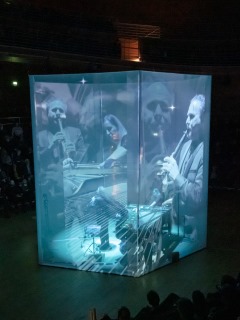

Visionary performers and creators David Krakauer and Kathleen Tagg have released Breath & Hammer on their own Table Pounding Records.

Artistic Statement:

For this album, we created the raw material by recording thousands of our own clarinet and piano sounds. We then wove together extended techniques and our completely untreated samples to create a large scale quasi-orchestral tapestry. No other instruments or samples are used, and many of the pieces are made up of 40 or more layers of prepared “piano orchestra” and clarinet. Fundamentally Breath & Hammer is about connections between people and a celebration of identity through music. The album is a mix of our own compositions along with our arrangements of song-form pieces gifted to us by our brilliant friends and collaborators from totally different backgrounds, genres and musical points of view: New York saxophone maverick John Zorn, Syrian clarinetist and composer Kinan Azmeh, Cuban percussionist Roberto Rodriguez, accordionist and forró specialist Rob Curto, and traditional master of Moldavian music Emil Kroitor. Our journey is global yet somehow very personally connected to the two of us; with our own pieces that reflect on cultural heritage, Curto’s Brazilian forró tune which we cast over a “drum circle” (all made of piano samples) inspired by Nigerian traditional musicians, a danzón from Rodriguez’s collection of imaginary Cuban Jewish music, Azmeh’s haunting evocation of the feeling of home and belonging, two pieces from Zorn’s magnum opus: “The Book of Angels” and Kroitor’s poignant ode to his homeland. We invite you to join us on this voyage that we call Breath & Hammer: The Ties That Bind Us.
-David Krakauer and Kathleen Tagg
Q & A with Kathleen Tagg about Breath & Hammer:
When did you first start employing extended techniques in your playing?
Kathleen Tagg: Well, contemporary classical music has done it for years and years. In the early 2000s, for about 10 years, I was heavily involved in playing a lot of contemporary music in New York with a lot of different groups, and there you really encounter a lot. It's not a new phenomenon. You see it back over a hundred years ago in the music of Henry Cowell. But for me really getting into it and finding my own techniques has been in the last eight years or so.
How did you choose repertoire for this project? It looks like you pull from composers across the musical spectrum.
All the composers are people we know, close friends or colleagues in New York who come from all around the world. Literally what we get from them is a lead sheet, and for some people that means three lines with nothing but melodies, for some of them it means chord structures – one of them also had one measure of a bassline. Some have tempo indications or approximations; most don’t. We then pull it out into these pieces that are much longer: we figure out how we want to set it in terms of form, what parts we want to blow up and extend, and what the sound is going to be. Each piece is really, really different. And these are people who we tremendously admire, respect and love. We just said, ‘Can we play one of your tunes and would you mind if we really sort of mess with it and recast it and rearrange it or find a new way to cover it?’ And they all said yes.
Your piano parts and extended techniques are so complex, I’m curious about the process of taking these pieces and arranging them for that unique soundscape.
I actually work very much in terms of orchestral instruments and then imagined orchestral instruments. I will make full huge orchestral scores for my piano parts, coming up with string parts, violins, cellos, even things like French horn. Then, depending on the piece, I'll also think of imaginary instruments like, say, strawberry angel shimmers. Things that sound just flashy and electronic, but that might fit in with an orchestra. And I'll often have very complex percussion. David and I will then go and workshop it, and David will always come up with great riffs, great ideas. We'll look at the structure, see what works, what doesn't work, add additional stuff in. So it's always a two-way street; it really goes back and forth.
How did you first come up with the concept behind Breath and Hammer?
David and I were trying to think of something that we could do together, and we kept coming back to this idea of New York songs and really looking at New York as a place where you had the whole world coming through. We knew these incredible people from around the world but all as personal connections. These were just our friends. And they allowed us to have access to their music, but then to cast it in a way that makes sense to us. I think that's the big key. We're not trying to sound like them, but to make something very much our own that still honors the original. What is incredible about each of these people is that they gave their blessings to us.
Photo Credits:
(1ff) David Krakauer & Kathleen Tagg
(unknown/website).